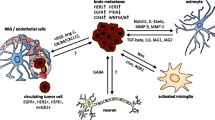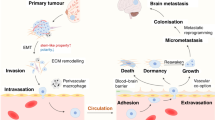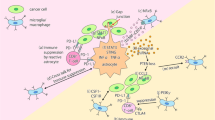Abstract
Breast cancer is the most common malignancy in woman in the USA. Metastasis is a major cause of morbidity and mortality in breast cancer patients. Total incidence of brain metastases of breast cancer is about 30%. Because of the improvements in control of systemic disease, for example the successful use of Trastuzumab, and the consequent prolonged life span, the incidence of brain metastases is increasing in breast cancer patients. The progressive neurological disabilities not only impair the quality of life, but also decrease the survival in patients. However, current treatments are of limited effectiveness. This is partially caused by the unique structure of the blood brain barrier. So far very little is known about the mechanisms how breast cancer metastizes to the brain. Some studies showed that ErbB2 overexpression is associated with the brain metastatic phenotype. Other molecules, like vascular endothelial growth factor (VEGF), matrix metalloproteinases (MMPs) and chemokine receptor CXCR4 are also involved in the metastasis of breast cancer cell to the brain. The current review will briefly overview the clinical features of brain metastasis of breast cancer and discusses the relationship of blood brain barrier and ErbB2 signal pathway to brain metastasis in breast cancer.
Similar content being viewed by others
References
Barnholtz-Sloan, J. S., Sloan, A. E., Davis, F. G., Vigneau, F. D., Lai, P., & Sawaya, R. E. (2004). Incidence proportions of brain metastases in patients diagnosed (1973 to 2001) in the Metropolitan Detroit Cancer Surveillance System. Journal of Clinical Oncology, 22, 2865–872.
Lin, N. U., Bellon, J. R., & Winer, E. P. (2004). CNS metastases in breast cancer. Journal of Clinical Oncology, 22, 3608–617.
Patanaphan, V., Salazar, O. M., & Risco, R. (1988). Breast cancer: Metastatic patterns and their prognosis. Southern Medical Journal, 81, 1109–112.
Tsukada, Y., Fouad, A., Pickren, J. W., & Lane, W. W. (1983). Central nervous system metastasis from breast carcinoma. Autopsy study. Cancer, 52, 2349–354.
Weil, R. J., Palmieri, D. C., Bronder, J. L., Stark, A. M., & Steeg, P. S. (2005). Breast cancer metastasis to the central nervous system. American Journal of Pathology, 167, 913–20.
Miller, K. D., Weathers, T., Haney, L. G., Timmerman, R., Dickler, M., Shen, J., et al. (2003). Occult central nervous system involvement in patients with metastatic breast cancer: Prevalence, predictive factors and impact on overall survival. Annals of Oncology, 14, 1072–077.
Lee, Y. T. (1983). Breast carcinoma: Pattern of metastasis at autopsy. Journal of Surgical Oncology, 23, 175–80.
Cho, S. Y., & Choi, H. Y. (1980). Causes of death and metastatic patterns in patients with mammary cancer. Ten-year autopsy study. American Journal of Clinical Pathology, 73, 232–34.
Kesari, S., & Batchelor, T.T. (2003). Leptomeningeal metastases. Neurologic Clinics, 21, 25–6.
Gabos, Z., Sinha, R., Hanson, J., Chauhan, N., Hugh, J., Mackey, J. R., et al. (2006). Prognostic significance of human epidermal growth factor receptor positivity for the development of brain metastasis after newly diagnosed breast cancer. Journal of Clinical Oncology, 24, 5658–663.
Pestalozzi, B. C., Zahrieh, D., Price, K. N., Holmberg, S. B., Lindtner, J., Collins, J., et al. (2006). Identifying breast cancer patients at risk for central nervous system (CNS) metastases in trials of the International Breast Cancer Study Group (IBCSG). Annals of Oncology, 17, 935–44.
Hicks, D. G., Short, S. M., Prescott, N. L., Tarr, S. M., Coleman, K. A., Yoder, B. J., et al. (2006). Breast cancers with brain metastases are more likely to be estrogen receptor negative, express the basal cytokeratin CK5/6, and overexpress HER2 or EGFR. American Journal of Surgical Pathology, 30, 1097–104.
Tham, Y. L., Sexton, K., Kramer, R., Hilsenbeck, S., & Elledge, R. (2006). Primary breast cancer phenotypes associated with propensity for central nervous system metastases. Cancer, 107, 696–04.
Stemmler, H. J., Kahlert, S., Siekiera, W., Untch, M., Heinrich, B., & Heinemann, V. (2006). Characteristics of patients with brain metastases receiving trastuzumab for HER2 overexpressing metastatic breast cancer. Breast, 15, 219–25.
Chang, J., Clark, G. M., Allred, D. C., Mohsin, S., Chamness, G., & Elledge, R. M. (2003). Survival of patients with metastatic breast carcinoma: Importance of prognostic markers of the primary tumor. Cancer, 97, 545–53.
Souglakos, J., Vamvakas, L., Apostolaki, S., Perraki, M., Saridaki, Z., Kazakou, I., et al. (2006). Central nervous system relapse in patients with breast cancer is associated with advanced stages, with the presence of circulating occult tumor cells and with the HER2/neu status. Breast Cancer Research, 8, R36.
Forsyth, P. A., & Posner, J. B. (1993). Headaches in patients with brain tumors: a study of 111 patients. Neurology, 43, 1678–683.
Lassman, A. B., & DeAngelis, L. M. (2003). Brain metastases. Neurologic Clinics, 21, 1–3, vii.
Fizazi, K., Asselain, B., Vincent-Salomon, A., Jouve, M., Dieras, V., Palangie, T., et al. (1996). Meningeal carcinomatosis in patients with breast carcinoma. Clinical features, prognostic factors, and results of a high-dose intrathecal methotrexate regimen. Cancer, 77, 1315–323.
Schellinger, P. D., Meinck, H. M., & Thron, A. (1999). Diagnostic accuracy of MRI compared to CCT in patients with brain metastases. Journal of Neuro-oncology, 44, 275–81.
Jeyapalan, S. A., & Batchelor, T. T. (2000). Diagnostic evaluation of neurologic metastases. Cancer Investigation, 18, 381–94.
Davis, P. C., Hudgins, P. A., Peterman, S. B., & Hoffman, J. C. Jr. (1991). Diagnosis of cerebral metastases: Double-dose delayed CT vs contrast-enhanced MR imaging. AJNR American Journal of Neuroradiology, 12, 293–00.
Akeson, P., Larsson, E. M., Kristoffersen, D. T., Jonsson, E., & Holtas, S. (1995). Brain metastases-comparison of gadodiamide injection-enhanced MR imaging at standard and high dose, contrast-enhanced CT and non-contrast-enhanced MR imaging. Acta Radiologica, 36, 300–06.
Sze, G., Milano, E., Johnson, C., & Heier, L. (1990). Detection of brain metastases: Comparison of contrast-enhanced MR with unenhanced MR and enhanced CT. AJNR American Journal of Neuroradiology, 11, 785–91.
Straathof, C. S., de Bruin, H. G., Dippel, D. W., & Vecht, C. J. (1999). The diagnostic accuracy of magnetic resonance imaging and cerebrospinal fluid cytology in leptomeningeal metastasis. Journal of Neurology, 246, 810–14.
Patchell, R. A., Tibbs, P. A., Walsh, J. W., Dempsey, R. J., Maruyama, Y., Kryscio, R. J., et al. (1990). A randomized trial of surgery in the treatment of single metastases to the brain. New England Journal of Medicine, 322, 494–00.
Shaffrey, M. E., Mut, M., Asher, A. L., Burri, S. H., Chahlavi, A., Chang, S. M., et al. (2004). Brain metastases. Current Problems in Surgery, 41, 665–41.
Engel, J., Eckel, R., Aydemir, U., Aydemir, S., Kerr, J., Schlesinger-Raab, A., et al. (2003). Determinants and prognoses of locoregional and distant progression in breast cancer. International Journal of Radiation Oncology, Biology, Physics, 55, 1186–195.
Gaspar, L., Scott, C., Rotman, M., Asbell, S., Phillips, T., Wasserman, T., et al. (1997). Recursive partitioning analysis (RPA) of prognostic factors in three Radiation Therapy Oncology Group (RTOG) brain metastases trials. International Journal of Radiation Oncology, Biology, Physics, 37, 745–51.
Lagerwaard, F. J., & Levendag, P. C. (2001). Prognostic factors in patients with brain metastases. Forum (Genova), 11, 27–6.
Bendell, J. C., Domchek, S. M., Burstein, H. J., Harris, L., Younger, J., Kuter, I., et al. (2003). Central nervous system metastases in women who receive trastuzumab-based therapy for metastatic breast carcinoma. Cancer, 97, 2972–977.
Peacock, K. H., & Lesser, G. J. (2006). Current therapeutic approaches in patients with brain metastases. Current Treatment Options in Oncology, 7, 479–89.
Bindal, R. K., Sawaya, R., Leavens, M. E., & Lee, J. J. (1993). Surgical treatment of multiple brain metastases. Journal of Neurosurgery, 79, 210–16.
Hazuka, M. B., Burleson, W. D., Stroud, D. N., Leonard, C. E., Lillehei, K. O., & Kinzie, J. J. (1993). Multiple brain metastases are associated with poor survival in patients treated with surgery and radiotherapy. Journal of Clinical Oncology, 11, 369–73.
Suh, J. H., Stea, B., Nabid, A., Kresl, J. J., Fortin, A., Mercier, J. P., et al. (2006). Phase III study of efaproxiral as an adjunct to whole-brain radiation therapy for brain metastases. Journal of Clinical Oncology, 24, 106–14.
Valtonen, S., Timonen, U., Toivanen, P., Kalimo, H., Kivipelto, L., Heiskanen, O., et al. (1997). Interstitial chemotherapy with carmustine-loaded polymers for high-grade gliomas: A randomized double-blind study. Neurosurgery, 41, 44–8 (discussion 48–9).
Grossi, P. M., Ochiai, H., Archer, G. E., McLendon, R. E., Zalutsky, M. R., Friedman, A. H., et al. (2003). Efficacy of intracerebral microinfusion of trastuzumab in an athymic rat model of intracerebral metastatic breast cancer. Clinical Cancer Research, 9, 5514–520.
Ballabh, P., Braun, A., & Nedergaard, M. (2004). The blood’brain barrier: An overview: Structure, regulation, and clinical implications. Neurobiology of Disease, 16, 1–3.
Lee, B. C., Lee, T. H., Avraham, S., & Avraham, H. K. (2004). Involvement of the chemokine receptor CXCR4 and its ligand stromal cell-derived factor 1alpha in breast cancer cell migration through human brain microvascular endothelial cells. Molecular Cancer Research, 2, 327–38.
Jong, A. Y., Stins, M. F., Huang, S. H., Chen, S. H., & Kim, K. S. (2001). Traversal of Candida albicans across human blood’brain barrier in vitro. Infection and Immunity, 69, 4536–544.
Clark, P. R., Manes, T. D., Pober, J. S., & Kluger, M. S. (2007). Increased ICAM-1 expression causes endothelial cell leakiness, cytoskeletal reorganization and junctional alterations. Journal of Investigative Dermatology, 127, 762–74.
Olayioye, M. A., Neve, R. M., Lane, H. A., & Hynes, N. E. (2000). The ErbB signaling network: Receptor heterodimerization in development and cancer. EMBO Journal, 19, 3159–167.
Hynes, N. E., & Stern, D. F. (1994). The biology of erbB-2/neu/HER-2 and its role in cancer. Biochimica et Biophysica Acta, 1198, 165–84.
Slamon, D. J., Clark, G. M., Wong, S. G., Levin, W. J., Ullrich, A., & McGuire, W. L. (1987). Human breast cancer: Correlation of relapse and survival with amplification of the HER-2/neu oncogene. Science, 235, 177–82.
Slamon, D. J., Godolphin, W., Jones, L. A., Holt, J. A., Wong, S. G., Keith, D. E., et al. (1989). Studies of the HER-2/neu proto-oncogene in human breast and ovarian cancer. Science, 244, 707–12.
Miller, S. J., Xing, X., Xi, L., & Hung, M. C. (1996). Identification of a specific DNA region required for enhanced transcription of HER2/neu in the MDA’MB453 breast cancer cell line. DNA and Cell Biology, 15, 749–57.
Mansour, E. G., Ravdin, P. M., & Dressler, L. (1994). Prognostic factors in early breast carcinoma. Cancer, 74, 381–00.
Andrulis, I. L., Bull, S. B., Blackstein, M. E., Sutherland, D., Mak, C., Sidlofsky, S., et al. (1998). Neu/erbB-2 amplification identifies a poor-prognosis group of women with node-negative breast cancer. Toronto Breast Cancer Study Group. Journal of Clinical Oncology, 16, 1340–349.
Pegram, M. D., Pauletti, G., & Slamon, D. J. (1998). HER-2/neu as a predictive marker of response to breast cancer therapy. Breast Cancer Research and Treatment, 52, 65–7.
Yu, D., & Hung, M. C. (2000). Overexpression of ErbB2 in cancer and ErbB2-targeting strategies. Oncogene, 19, 6115–121.
Meric-Bernstam, F., & Hung, M. C. (2006). Advances in targeting human epidermal growth factor receptor-2 signaling for cancer therapy. Clinical Cancer Research, 12, 6326–330.
Zhou, B. P., Liao, Y., Xia, W., Spohn, B., Lee, M. H., & Hung, M. C. (2001). Cytoplasmic localization of p21Cip1/WAF1 by Akt-induced phosphorylation in HER-2/neu-overexpressing cells. Nature Cell Biology, 3, 245–52.
Xia, W., Chen, J. S., Zhou, X., Sun, P. R., Lee, D. F., Liao, Y., et al. (2004). Phosphorylation/cytoplasmic localization of p21Cip1/WAF1 is associated with HER2/neu overexpression and provides a novel combination predictor for poor prognosis in breast cancer patients. Clinical Cancer Research, 10, 3815–824.
Zhou, B. P., Liao, Y., Xia, W., Zou, Y., Spohn, B., & Hung, M. C. (2001). HER-2/neu induces p53 ubiquitination via Akt-mediated MDM2 phosphorylation. Nature Cell Biology, 3, 973–82.
Yang, H. Y., Zhou, B. P., Hung, M. C., & Lee, M. H. (2000). Oncogenic signals of HER-2/neu in regulating the stability of the cyclin-dependent kinase inhibitor p27. Journal of Biological Chemistry, 275, 24735–4739.
Ding, Q., Xia, W., Liu, J. C., Yang, J. Y., Lee, D. F., Xia, J., et al. (2005). Erk associates with and primes GSK-3beta for its inactivation resulting in upregulation of beta-catenin. Molecular Cell, 19, 159–70.
Klos, K. S., Wyszomierski, S. L., Sun, M., Tan, M., Zhou, X., Li, P., et al. (2006). ErbB2 increases vascular endothelial growth factor protein synthesis via activation of mammalian target of rapamycin/p70S6K leading to increased angiogenesis and spontaneous metastasis of human breast cancer cells. Cancer Research, 66, 2028–037.
Li, Y. M., Pan, Y., Wei, Y., Cheng, X., Zhou, B. P., Tan, M., et al. (2004). Upregulation of CXCR4 is essential for HER2-mediated tumor metastasis. Cancer Cell, 6, 459–69.
Kallioniemi, O. P., Holli, K., Visakorpi, T., Koivula, T., Helin, H. H., & Isola, J. J. (1991). Association of c-erbB-2 protein over-expression with high rate of cell proliferation, increased risk of visceral metastasis and poor long-term survival in breast cancer. International Journal of Cancer, 49, 650–55.
Slamon, D. J., Leyland-Jones, B., Shak, S., Fuchs, H., Paton, V., Bajamonde, A., et al. (2001). Use of chemotherapy plus a monoclonal antibody against HER2 for metastatic breast cancer that overexpresses HER2. New England Journal of Medicine, 344, 783–92.
Yau, T., Swanton, C., Chua, S., Sue, A., Walsh, G., Rostom, A., et al. (2006). Incidence, pattern and timing of brain metastases among patients with advanced breast cancer treated with trastuzumab. Acta Oncologica, 45, 196–01.
Altaha, R., Crowell, E., Hobbs, G., Higa, G., & Abraham, J. (2005). Increased risk of brain metastases in patients with HER-2/neu-positive breast carcinoma. Cancer, 103, 442–43.
Clayton, A. J., Danson, S., Jolly, S., Ryder, W. D., Burt, P. A., Stewart, A. L., et al. (2004). Incidence of cerebral metastases in patients treated with trastuzumab for metastatic breast cancer. British Journal of Cancer, 91, 639–43.
Shmueli, E., Wigler, N., & Inbar, M. (2004). Central nervous system progression among patients with metastatic breast cancer responding to trastuzumab treatment. European Journal of Cancer, 40, 379–82.
Fuchs, I. B., Loebbecke, M., Buhler, H., Stoltenburg-Didinger, G., Heine, B., Lichtenegger, W., et al. (2002). HER2 in brain metastases: Issues of concordance, survival, and treatment. Journal of Clinical Oncology, 20, 4130–133.
Robins, H. I., Liu, G., Hayes, L., & Mehta, M. (2002). Trastuzumab for breast cancer-related carcinomatous meningitis. Clinical Breast Cancer, 2, 316.
Stemmler, H. J., Schmitt, M., Willems, A., Bernhard, H., Harbeck, N., & Heinemann, V. (2007). Ratio of trastuzumab levels in serum and cerebrospinal fluid is altered in HER2-positive breast cancer patients with brain metastases and impairment of blood’brain barrier. Anticancer Drugs, 18, 23–8.
Bergman, I., Barmada, M. A., Griffin, J. A., & Slamon, D. J. (2001). Treatment of meningeal breast cancer xenografts in the rat using an anti-p185/HER2 antibody. Clinical Cancer Research, 7, 2050–056.
Montemurro, F., Valabrega, G., & Aglietta, M. (2007). Lapatinib: A dual inhibitor of EGFR and HER2 tyrosine kinase activity. Expert Opinion on Biological Therapy, 7, 257–68.
Dewji, M. R. (2004). Early phase I data on an irreversible pan-erb inhibitor: CI-1033. What did we learn? Journal of Chemotherapy, 16(Suppl 4), 44–8.
Fidler, I. J. (2002). The organ microenvironment and cancer metastasis. Differentiation, 70, 498–05.
Monsky, W. L., Mouta Carreira, C., Tsuzuki, Y., Gohongi, T., Fukumura, D., & Jain, R. K. (2002). Role of host microenvironment in angiogenesis and microvascular functions in human breast cancer xenografts: Mammary fat pad versus cranial tumors. Clinical Cancer Research, 8, 1008–013.
Linderholm, B., Grankvist, K., Wilking, N., Johansson, M., Tavelin, B., & Henriksson, R. (2000). Correlation of vascular endothelial growth factor content with recurrences, survival, and first relapse site in primary node-positive breast carcinoma after adjuvant treatment. Journal of Clinical Oncology, 18, 1423–431.
Lee, T. H., Avraham, H. K., Jiang, S., & Avraham, S. (2003). Vascular endothelial growth factor modulates the transendothelial migration of MDA-MB-231 breast cancer cells through regulation of brain microvascular endothelial cell permeability. Journal of Biological Chemistry, 278, 5277–284.
Kim, L. S., Huang, S., Lu, W., Lev, D. C., & Price, J. E. (2004). Vascular endothelial growth factor expression promotes the growth of breast cancer brain metastases in nude mice. Clinical & Experimental Metastasis, 21, 107–18.
Mendes, O., Kim, H. T., & Stoica, G. (2005). Expression of MMP2, MMP9 and MMP3 in breast cancer brain metastasis in a rat model. Clinical & Experimental Metastasis, 22, 237–46.
Tester, A. M., Waltham, M., Oh, S. J., Bae, S. N., Bills, M. M., Walker, E. C., et al. (2004). Pro-matrix metalloproteinase-2 transfection increases orthotopic primary growth and experimental metastasis of MDA-MB-231 human breast cancer cells in nude mice. Cancer Research, 64, 652–58.
Stark, A. M., Anuszkiewicz, B., Mentlein, R., Yoneda, T., Mehdorn, H. M., & Held-Feindt, J. (2007). Differential expression of matrix metalloproteinases in brain- and bone-seeking clones of metastatic MDA-MB-231 breast cancer cells. Journal of Neuro-oncology, 81, 39–8.
Muller, A., Homey, B., Soto, H., Ge, N., Catron, D., Buchanan, M. E., et al. (2001). Involvement of chemokine receptors in breast cancer metastasis. Nature, 410, 50–6.
Andre, F., Cabioglu, N., Assi, H., Sabourin, J. C., Delaloge, S., Sahin, A., et al. (2006). Expression of chemokine receptors predicts the site of metastatic relapse in patients with axillary node positive primary breast cancer. Annals of Oncology, 17, 945–51.
Schmid, B. C., Rezniczek, G. A., Fabjani, G., Yoneda, T., Leodolter, S., & Zeillinger, R. (2007). The neuronal guidance cue Slit2 induces targeted migration and may play a role in brain metastasis of breast cancer cells. Breast Cancer Research and Treatment.
Author information
Authors and Affiliations
Corresponding author
Rights and permissions
About this article
Cite this article
Cheng, X., Hung, MC. Breast cancer brain metastases. Cancer Metastasis Rev 26, 635–643 (2007). https://doi.org/10.1007/s10555-007-9083-x
Published:
Issue Date:
DOI: https://doi.org/10.1007/s10555-007-9083-x




